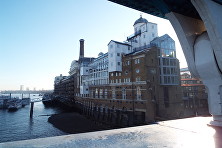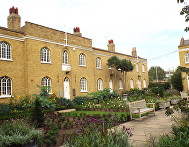





Exploring Southwark and discovering its history


Latest Pages:
It’s a very modest plaque for the impact this invention had around the world and makes no mention of other inventions built on the same site by Bryan Donkin, a most innovative engineer.
He was born in Northumberland in 1768. His father was a land agent to the Duke of Northumberland and Bryan followed in his father’s footsteps, moving south to Sevenoaks to become a land agent for the Duke of Dorset at Knowle. He had though always had a very keen interest in mechanics and after four years decided to follow his heart when he became apprenticed to John Hall who installed machinery at paper mills. John Hall was given the task of developing a patent by the Fourdrinier Brothers, a stationery firm in London, for the manufacture of a continuous paper making machine that advanced a patent brought over from France by John Gamble. Hall passed the project on to Bryan Donkin who carried out the work on the site on Fort Place, Southwark Park Road (then called Blue Anchor Lane) which had been leased by the Fourdrinier Brothers in 1802. By 1810, 18 machines had been built. In the meantime, Donkin had patented the first steel pen and had invented a tachometer, for measuring the speed of machines, for which he was awarded a gold medal from the Society of Arts.
A great deal of research had been carried out in different countries to devise a means of preserving meat and vegetables for long periods of time, not to serve a domestic market but to feed the army overseas and ships’ crews, as a more nutritious and more appealing alternative to salted beef and hard biscuits. In France, at the beginning of 1810, Nicholas Appert developed a method whereby food was sealed in glass jars and then placed in boiling water. Later that same year, another Frenchman Phillipe de Girard, devised a means of preserving food in iron canisters, a much stronger alternative to glass containers. This latter method was patented in London by de Girard’s English agent Peter Durand in August 1810. Understanding the potential of this patent, Bryan Donkin seized the opportunity and purchased the patent from Durand the following year though it took two more years to complete the transfer.
Donkin had purchased the lease of the Fort Place site from the Fourdrinier Brothers and built another factory on the land where he developed the patent using tin lined iron. He had set up a company with John Hall and John Gamble named Donkin Hall and Gamble. The roles were clear cut: Donkin was the engineer who developed the process, John Hall invested money into the business and John Gamble oversaw the running of the factory and the translation of Donkin’s engineering into production. By 1813 the process had been developed to an extent to show the end result to interested parties.
The Duke of Wellington found the canned beef very tasty and recommended it to the Army and Navy. The President of the Royal Society, Sir Joseph Banks, declared the beef to be “in a perfect state of preservation, and had not lost any nutritious qualities”. The highest accolade came from the Duke of Kent who, having tasted the canned beef once and finding it “perfectly good” requested some more which was served to the Duke of York, the Queen, the Prince Regent (later George IV) and several distinguished personages, who “highly approved of the canned beef.” Orders followed from the Royal Navy and the explorer Sir Edward Parry. Donkin’s canned food was a success but still too expensive for the domestic market.
Bryan Donkin - the inventor of the tin can
Mounted high up on the side of an old caretaker’s house in the grounds of Harris Academy facing onto Southwark Park Road, is a tiled plaque bearing the following inscription:
"In a factory on this site
BRYAN DONKIN FRS
and
JOHN GAMBLE
produced the first
canned foods
1812 AD"



In 1821, Donkin dissolved the partnership with Gamble, perhaps because he had met the engineering challenge and wanted to move on to other projects. John Gamble moved the canning business to Ireland and Donkin continued at the premises in Fort Place, Southwark Park Road where he:
-
supplied the engine and machinery for a dredger for Thomas Telford for the Caledonian Canal and also steam engines for use at the canal’s locks
-
Developed a method of printing stamps in two colours with further work commissioned by the Excise and Stamp Office
-
Developed a printing machine
-
Undertook work commissioned by the East India Company
-
Built a dredger for the Gotha Canal
-
Made a high precision dividing engine/screw cutting lathe.
-
Built a dredger for Calder and Hubble
-
He was a director of Brunel’s Thames Tunnel and supplied equipment for pumping water out of the tunnel and modified the tunnelling shield
-
Was commissioned to prepare an estimate of the development costs of Charles Babbage’s calculating machine.
He had founded the company Bryan Donkin and Co in 1803 and after his death in 1855 the firm was run by his sons and later his grandsons. A hundred years after its formation, the company left the Fort Place premises and moved to Chesterfield where it amalgamated with Clench and Co, the new company beimg known for a short period as Bryan Donkin and Clench before being renamed again as Bryan Donkin Co. The Donkin name lives on in Bryan Donkin Valves, a subsidiary of AVK UK.
As the plaque on the side of the caretakers house is modest so too was the first Bryan Donkin and although his contribution to engineering in the 19th century was enormous, his is not a household name today. More can be found out about this fascinating man and his achievements at https://bryandonkin.wordpress.com He lived in The Paragon, New Kent Road and is buried at Nunhead Cemetery.
The Donkin family tomb in Nunhead Cemetery
Web discoveries
- UK Casino Not On Gamstop
- UK Casino Not On Gamstop
- Non Gamstop Casino
- Casinos Not On Gamstop
- Non Gamstop Casinos
- Non Gamstop Casinos
- Non Gamstop Casino
- Casino Sites Not On Gamstop
- Slots Not On Gamstop
- Casinos Not On Gamstop
- UK Betting Sites Not On Gamstop
- UK Casino Not On Gamstop
- Best Non Gamstop Casinos
- Betting Sites
- Non Gamstop Casino Sites UK
- Best Non Gamstop Casinos
- Non Gamstop Casino
- Casinos Not On Gamstop
- Non Gamstop Casino Sites UK